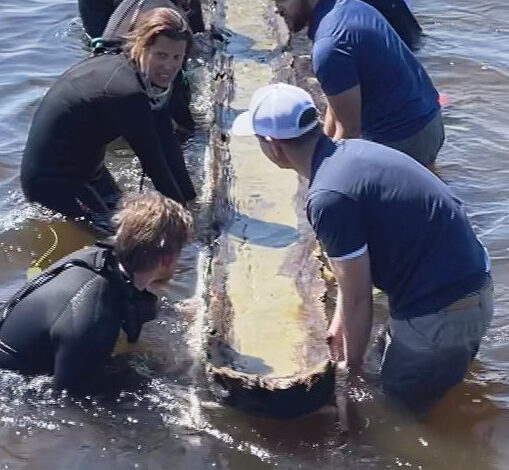Sunken treasures in North Carolina found by three local teens

A treasure trove of history, the waters of North Carolina tell the stories of ancient Indians and swashbuckling pirates who once sailed the seas and walked the lands.
The notorious pirate Blackbeard and the Waccamaw Siouan Indians had nothing in common until a recent discovery.
An ancient canoe, that’s more than 1000 years old, was found in the waterways of North Carolina, close to where an 18th century French slave ship was recovered.
The ship, originally called La Concorde, was involved in many attacks from Africa to the Caribbean and settled in its watery graveyard off the coast of North Carolina, after it was grounded in the shallow waters by Edward Thatch, famously known as the ruthless pirate Blackbeard.
Renamed Queen Anne’s Revenge after it was captured by Blackbeard in 1717, the ship has been stuck since in May 1718, and when it was discovered in 1996, the wreck was brought to the surface with a bounty of artifacts, like the anchor and loaded canons of all sizes, retrieved.
The dugout canoe, pre-dating Queen’s Anne Revenge by hundreds of years, was pulled in April 2023 from the swampy waters of Lake Waccamaw, about two and a half hours southwest of Beaufort Inlet, where Blackbeard’s ship ran aground.
The canoe didn’t carry seafaring pirates battling the oceans for supremacy, but it is a priceless treasure to Waccamaw Siouan Indians of North Carolina.
According to Waccamaw Siouan Chief Michael Jacobs, “That canoe at 28 feet long would have carried many a brave.” Removed after it was found almost two years, Jacobs said the discovery of the canoe will help in understanding their past. “We feel like in our heart, it’s a history that we’re still exploring and understanding because this is the first time we’ve had access.”

The canoe was found in the summer of 2021 by three local teens, Eli Hill, Jackson Holcomb, and Creek Hyatt, who were swimming in the lake.
“I stepped on it and I thought it was a log,” said Hill. “I tried to pick it up and it never came up. So, we kept digging at it and it just kept going. And then the next day, we came back and we started digging some more and it just kept going.”
Hill’s family contacted The North Carolina Office of State Archaeology and a team brought it closer to the family’s pier, where it stayed, submerged in muddy waters for two years.
Jacobs earlier explained that if sunken artifacts are mishandled, or improperly exposed to air, it will crumble and be destroyed. The lengthy process involves a lot of planning, starting with submerging it in a chemical bath to remove the moisture. Jacobs said, “As long as it stays in the lake water, it’s preserved.”
When the canoe was brought to the surface, dozens of members of the Waccamaw Siouan Tribe were there. Jacobs said, “Our history is still unfolding. When the colonists made contact with our tribe, there’s a lot of the things that we hailed as historical and meaningful to us that we’re still putting together.”
The colonists he refers to date as far back as the 16th century, and the canoe provides evidence that the Waccamaw Siouans were there long before.
“We’re looking forward to examining it, running some tests on it, really finding out and going back to our elders and getting the history of it to where we can teach the truth to our people and know that we’ve got concrete evidence to stand on,” said Jacobs.
This wasn’t the first canoe found buried in the lake. It turns out the alligator-infested waterways in southeastern North Carolina hold many secrets.
In October, 2022, a 23-foot waterlogged canoe, carbon dated to be 940 years old, was pulled from the same lake, also belonging to the Waccamaw Siouan Indians. The canoe was discovered, nearly intact about two years before and Jacobs said other canoes have been found at the lake, and there are still some buried under the water.

A team from the Fort Fisher Historic Site helped recovering the large dugout canoe and explained how ancient Indians would make these simple, yet largely effective watercrafts.
“This dugout canoe was found nearly intact at Lake Waccamaw. To make these marvels, American Indians would roll large logs into the lake to identify the heaviest side. That heavy side, which would sink below the water, became the bottom of the canoe. The rest of the tree was carefully dug out and burned away. You can still see the scorch marks on this canoe today!”
Jacobs was on site when this canoe was pulled and was overwhelmed. “I couldn’t do nothing but cry,” he said.
If you live in the Carolinas, you can arrange a visit at the conservation lab and see the artifacts from Queen Anne’s Revenge. As for the canoe, it will be treated at the same lab and will then be the first of many artifacts returned to its home at the Waccamaw Siouan tribal grounds in Buckhead, NC.
How amazing is it to find parts of our history, buried and preserved for so many years? There are reports of man existing as far back as 230,000 years ago, where fossilized impressions of hands and feet belonging to two children were found in Tibet, or even the hidden chapter of the bible that we recently reported.
What’s the greatest item you’ve found and what kind of artifact would you like to find?




